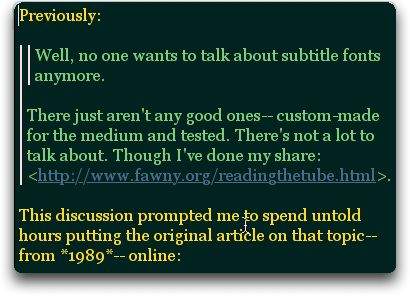![[Joe Clark: Accessibility | Design | Writing] Joe Clark: Accessibility | Design | Writing](/joeclark-angie-02IX.jpg)
![[Joe Clark: Accessibility | Design | Writing] Joe Clark: Accessibility | Design | Writing](/joeclark-angie-02IX.jpg)
format=flowed FAQIn the olden days, lines of quoted text were prefaced by the > character (greater-than), like so:
> In the olden days, lines > of quoted text were prefaced by the > greater-than character.
That system worked OK when everyone used Unix mail programs like Pine and Elm via terminal software. But even then, if the original line of text were unusually long, the results could be messy:
> That system worked OK when everyone used Unix mail programs like Pine and Elm via > terminal-emulation software. But even then,
With graphical E-mail programs like Eudora, if you resized the window, text would flow in an equally ugly way.
Things get worse when quoted text is itself quoted, because each level of quotation added a > character and possibly also a space. Inevitably, over time you ended up with quoted text where not every line began with a > even though it’s actually a quoted line. The results were hard to read and unattractive.
Yes, f=f text usually looks better.
Here’s what goes on. We’ll skip one technical detail in this explanation. (Don’t worry, you can read about it in the documentation section.) A mailer program that understands f=f suppresses the display of > characters. They’re still there, only hidden.
Instead, the mailer shows quoted text some other way – usually via an excerpt bar, a vertical bar drawn to the left of the quoted text. The mailer program treats the > characters as movable. If you add or delete text or resize the display window, the program recomputes where the > characters should go but keeps the quoted text tidy and well-flowed, hence the name "flowed text."
See the illustrations below. The first image shows a wide window, the second a narrower one. Note that the text in both paragraphs (the first of which is quoted two levels deep and contains an HTML bullet) reflows nicely.


The system works best when the text originates with a mailer that produces f=f text. Other mailers place hard carriage returns at the ends of lines, which, for a technical reason we’re not dwelling on here, even an f=f mailer has to respect.
If you receive a message from someone using, say, Pine or Elm (Message 1, we’ll call it), and then add some of your own text and forward the whole thing to your friend who also uses an f=f mailer (Message 2), when your friend resizes the message you are still stuck with the Message 1’s hard linebreaks. But when your friend replies to your message, the original text you typed in Message 2 will flow nicely when you resize your friend’s message or add or delete text.
In other words, f=f works best when the entire chain of a message uses f=f mailers.
Because f=f does not really alter the text of your message.
(There is a tiny alteration, but we’re glossing over that
technical detail.) Actually, what it mostly does is alter
the so-called content-type declaration in your
message.
Most E-mails you will receive (mail from spammers is usually not
in this category) will contain a hidden header that
tells the receiving mail program what kind of text to expect. A
very ordinary plain-text E-mail with no formatting at all (no HTML,
no flowed text) might have a
content-type of:
Content-Type: text/plain; charset="iso-8859-1"
A flowed-text message merely adds a simple term:
Content-Type: text/plain; charset="iso-8859-1"; format="flowed"
So an older mailer that doesn’t understand flowed text
doesn’t have to; it can simply ignore the
format="flowed" declaration in the header.
<BLOCKQUOTE>
element, which does what it says: It quotes blocks of text. When f=f mailers
that also can handle HTML encounter <BLOCKQUOTE>
text, it’s usually marked up with the same excerpt bars
we’re familiar with from f=f. Format=flowed isn’t
actually at work there, but since <BLOCKQUOTE>
text flows nicely when you resize a window, the effect is the
same.<BLOCKQUOTE> will now
be quoted with f=f, and will look fine in any recipient’s
mailer.You can turn off f=f within Macintosh Eudora, though there’s no reason to do so. Copy these characters into the body of a message:
<x-eudora-setting:260=1>
Then Command-click that text. (You will thus have engaged one of Eudora’s hundreds of semi-secret configuration codes. You can get a list of those codes via E-mail by sending a message to a special address at Tidbits.)
In Windows, copy these addresses into a message and Control- click:
<X-Eudora-Option:ConvertFormatFlowedtoExcerpt=0>
<X-Eudora-Option:InterpretFormatFlowed=0>
Along with the increased emphasis on excerpt bars comes better tools for dealing with them. Two new commands (to quote and unquote, Command-apostrophe and Option-Command-apostrophe) have been added to add and remove levels of excerpt. We believe that with these improvements, editing quoted material (whether to trim it or to respond to individual sections) will be much more convenient than it ever could have been using fixed quote characters.
Thanks are due to Steve Dorner, Randy Gellens, and Greg Brown of Eudora, though they have no connection to this f=fAQ and didn’t write anything that wasn’t attributed as such.
h1 and fixed an error 2004.03.18.You are here: joeclark.org → The format=flowed FAQ (f=fAQ)